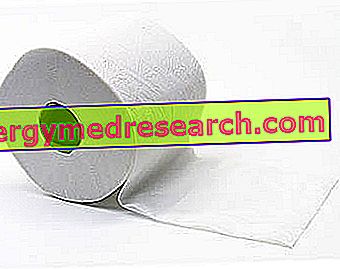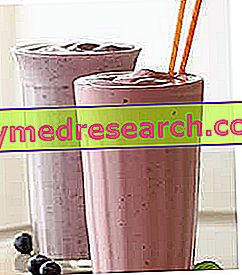Generality
The vov is a super-alcoholic drink that has the hen's egg as its characteristic ingredient.
The vov is a commercial version of the "liqueur zabaione", a homemade recipe to which tonic, energizing and restorative powers were attributed.
Over the years, vov has also become synonymous with the type of drink, so much so that even competitive products are often referred to by this name.
The main characteristics of the vov are: intense yellow color, creamy consistency, alcohol content of 17.8% and a typical aroma of egg yolk.

Ingredients
The ingredients of the vov are: egg yolk, marsala, sugar and aromas; there are no dyes and preservatives.
Nutritional Features
Unlike most spirits, the vov "should not" be an empty drink, that is, lacking nutritional components useful to the body. This statement is justifiable by the nature of the ingredients used for its production, including the egg yolk.
In fact, if it is true that ethyl alcohol is NOT a nutrient and that sucrose (sugar) does NOT represent a decisive chemical element for human health (on the contrary, in the Western diet it is often in excess), it is equally true that in the yolk of egg there are various molecules and ions of a certain interest.
Egg yolk gives the vov a certain lipid content, since 49.1% of fat is present inside this ingredient. Among these, we note: triglycerides (mainly composed of unsaturated fatty acids, but with a relevant percentage of saturated), cholesterol (> 1300mg / 100g), phosphatidylcholine (which structures lecithin) and fat-soluble vitamins (beta-carotene or pro vit A, calciferol or vit D and tocopherols or vit E).
Furthermore, egg yolk is also rich in hydrophilic molecules, among which proteins (with a high biological value) constitute about 15-16g / 100g. Among the others we observe: mineral salts (especially iron, phosphorus, zinc and selenium) and water-soluble vitamins (mainly thiamine or B1 and riboflavin or B2, but not only).
It is however necessary to specify that the nutritional characteristics of the vov could be estimated only indirectly, that is by scrutinizing the chemical composition of the ingredients. On the other hand, if for some elements the result is more or less overlapping, for others it can change radically. The chemical interactions between the alcohol and some molecules, as well as any reactions to heat (egg pasteurization), can irreversibly damage the vitamin fraction.
The average portion of vov is limited to about 2 daily 40ml units, due to its alcohol concentration (see next chapter).
Ethyl alcohol, which as we will see has several undesirable effects, however, if taken in moderation, does not imply limitations to all diseases of nutritional-metabolic interest; for example, it is tolerated both in case of type 2 diabetes mellitus, and in case of hypercholesterolemia.
Having said this, it is necessary to remember that the nutritional profile of the vov is characterized by the presence of sucrose, fatty acids and cholesterol, which is why, regardless of alcohol content, it must be excluded from clinical nutrition due to hyperglycemia, hypercholesterolemia, hypertriglyceridemia, overweight (which is negatively affected by alcohol, sucrose and fatty acids) and metabolic syndrome.
Homemade Vov
Egg Liqueur - Vov
X Problems with video playback? Reload from YouTube Go to Video Page Go to Video Recipes Section Watch the video on youtubeVov, Alcohol and Health
The vov is a liqueur with an alcohol content of 17.8% and this characteristic should limit its consumption to 40-80 and never above 120ml / day, divided into 1, 2 or 3 alcoholic units of 40ml. This parameter varies considerably based on age, sex and any special conditions; moreover, not all health and nutrition research institutes provide the same recruitment limits. In general, for a healthy adult, the average daily dose should be on the 2 40ml alcohol units.
Excessive intake of vov may be harmful both to people suffering from certain diseases and to perfectly healthy ones; the risks are the same as those associated with the excess of any alcoholic beverage, with some penalizing factors mentioned in the previous chapter.
Especially growing people and those in special physiological conditions (pregnant women and nurses) must totally abstain from eating vov.
Vov abuse can also favor the onset or worsening of various pathologies related to the consumption of ethyl alcohol; among these we remember: primary arterial hypertension, fatty liver steatosis of alcoholic origin (possibly, cirrhosis of the liver), gastritis (possibly, gastric ulcer and / or duodenal ulcer), gastro esophageal reflux (possibly, Barrett's esophagus), favors the acute diseases of crohn and ulcerative rectal colitis, renal fatigue (can contribute to organ failure) and various types of cancer, related or not, to the organs already mentioned (liver, esophagus, stomach, intestine, pancreas etc.).
The vov, much loved by skiers "on Sunday" (ingredient of the famous bombardino), is instead completely discouraged for athletes who practice intense activity. Although trained individuals generally have a more effective and efficient body than sedentaries, they are much more prone to nutritional imbalances. Let's see why.
Ethyl alcohol has a rather high diuretic and sweating effect; as is well known, both renal filtration and sweating, exploit a system of expulsion of water and toxins that involves the transport of mineral salts (especially sodium and potassium). This means that, in a state permanently prone to dehydration (typical of endurance athletes), exceeding with alcohol means hindering the restoration of the hydro-saline balance (instead necessary). Moreover, since it is a psychotropic molecule (not for nothing responsible for drug addiction), ethyl alcohol interferes with the correct sleep cycles, limiting rest and interfering with recovery.
In all subjects, ethyl alcohol compromises nutritional absorption, tends to cause diarrhea and alters vitamin metabolism (especially in vit B1).



